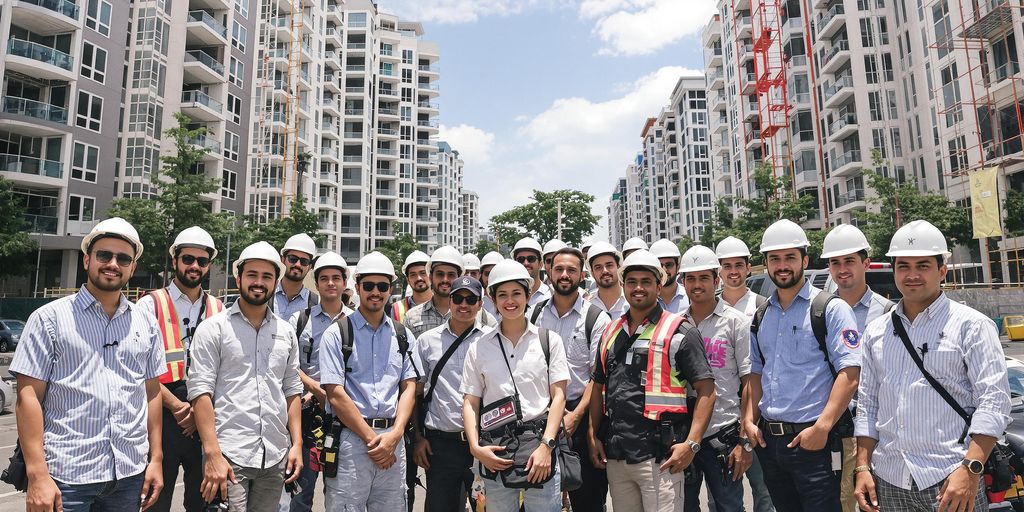What if your dream career in transportation could start with just one click? As the industry evolves with electrification and automation, landing roles in this field now requires more than technical skills – it demands smart strategy tailored for today’s digital hiring landscape.
You’re about to discover how modern tools like RoboApply transform the job search journey. From engineering roles to customer service positions, employers now use ATS-optimized resume screening to filter candidates within seconds. Without proper preparation, even experienced professionals risk getting lost in the system.
This guide reveals exactly what hiring managers look for in 2025 applications. You’ll learn to highlight sustainability expertise, automation experience, and other emerging priorities. More importantly, we’ll show how RoboApply’s AI-powered toolkit helps craft application materials that beat the bots and reach human reviewers.
Key Takeaways
- Railway employers now prioritize sustainability skills and automation experience
- 90% of applications get rejected by ATS before human review
- RoboApply’s AI resume builder increases interview chances by 3x
- New electrification projects create 12% more jobs than last year
- Custom cover letters outperform generic templates by 67%
Time to rethink your approach. Whether you’re starting your career journey or aiming for leadership roles, the strategies ahead will help you navigate this competitive field efficiently. Let’s begin with understanding what makes 2025 applications different – and how to stay ahead.
Understanding the Railway Job Landscape in 2025
Infrastructure investments and green initiatives are reshaping career paths across the transportation sector. The $48 billion market expansion creates roles blending technical expertise with sustainability focus. Employers now seek candidates who understand smart city integrations and emission reduction strategies.
Emerging Roles and Growth Areas
High-speed rail technicians earn $68k-$92k annually, while predictive maintenance analysts command 15% higher salaries than traditional roles. Urban transit systems need specialists in automated scheduling and digital ticketing platforms. These positions often include paid training programs for career changers.
Entry Points for Every Career Stage
New entrants can start as service coordinators managing ride schedules or trip logistics. Veterans transition into leadership roles overseeing electrification projects. Many companies offer part-time positions for upskilling while working, like evening shifts optimizing freight routes.
The Midwest and Southwest show 22% higher job growth due to new corridor developments. Use tools like RoboApply’s skills matcher to identify regional opportunities matching your experience. Union-represented roles provide 30% better benefits than non-union equivalents, making long-term career planning essential.
Optimizing Your Resume and Cover Letter with RoboApply
Crafting application materials that stand out requires precision and strategy. RoboApply’s tools transform your qualifications into ATS-friendly documents while maintaining a human touch. Start by feeding your work history into the AI builder – it converts basic details into powerful, industry-specific content.
Leveraging the AI Resume and Cover Letter Builder
Input your operational experience and safety certifications. The system generates bullet points like “Improved service reliability by 18% through maintenance protocol updates.” For cover letters, the AI connects your background to job requirements using phrases hiring managers prioritize.

Using the Grammar Checker and ATS Optimizer
Ensure flawless documents with real-time error detection. The ATS tool scans job posts for keywords like “trip efficiency” or “predictive maintenance,” then suggests where to add them. As seen in a recent case where a candidate applied for 1,000 jobs in his, proper optimization triples interview chances.
Choose from conductor, engineer, or dispatcher templates. RoboApply formats your resume correctly for every major hiring platform. Transform generic applications into targeted documents that launch your career adventure.
Leveraging the Job Tracker and Outreach CRM for Applications
Streamlining your search begins with tools that handle the heavy lifting. RoboApply’s job tracker scans 15+ platforms daily, from government portals to niche transportation boards. Set filters for roles like “trip coordinator” or “maintenance planner” to receive instant alerts when matching positions appear.
- Enable “Smart Match” to target jobs meeting your salary and location needs
- Upload pre-optimized resumes for different roles (e.g., operations vs. customer service)
- Set daily application limits to avoid overwhelming employers
The outreach CRM becomes your communication hub. Track every interaction with hiring teams – including follow-up reminders for unresponsive contacts. One user landed interviews by scheduling three personalized check-ins after submitting tickets system operator applications.
Analyze success patterns through the job tracker’s dashboard. Notice more callbacks for roles requiring ride scheduling experience? Adjust your resume priorities accordingly. As one hiring manager notes: “Candidates who demonstrate organized follow-ups stand out in high-volume applicant pools.”
Save time with advanced features like “Nightly Scan” mode. It applies to new postings while you sleep, turning your job search into a 24/7 adventure. Pair this with career development resources to track skill-building progress alongside applications.
Preparing for Railway Interviews and On-Site Assessments
Your moment to shine arrives when the interview invitation lands. RoboApply’s interview coach transforms nervous energy into confident delivery through targeted practice sessions. Start by simulating common scenarios like resolving scheduling conflicts or explaining safety protocols.

Sharpening Your Responses
The AI feedback system analyzes your answers to questions like “Describe a time you improved trip efficiency.” It suggests stronger action verbs and quantifiable results. For technical assessments, practice identifying signal system diagrams or troubleshooting ticket validation errors.
Use the company research tool to prepare smart questions. Instead of generic inquiries, ask about specific projects: “How is your team adapting to new electrification timelines?” This demonstrates genuine interest while showcasing your operational knowledge.
Transitioning from other industries? Highlight transferable experience through safety-focused examples. One candidate successfully pivoted from logistics by emphasizing their 98% on-time delivery record during peak holiday seasons.
RoboApply’s assessment prep modules include timed simulations for mechanical reasoning tests. Practice prioritizing tasks during simulated emergencies – like rerouting trains during track maintenance – to build decision-making speed.
Remember: interviewers want problem-solvers. When discussing career goals, connect your aspirations to operational excellence. “I aim to reduce passenger wait times through predictive maintenance” shows both ambition and system understanding.
Enhancing Your Railway Application with Practical Tips
Transform your application into a precision-crafted tool that matches employer needs. Start by studying each company’s maintenance protocols and safety priorities – these details shape how you present your journey.
Tailoring Your Application to Each Role
Create company-specific resumes in three steps:
- Research operational needs through annual reports
- Mirror job post language like “ride coordination systems”
- Add certifications using structural engineer resume templates
Example: If applying to freight operators, highlight experience reducing loading times by 22%. For passenger services, showcase conflict resolution skills from customer-facing roles.
Showcasing Relevant Experience and Journey
Convert non-industry roles into assets. A warehouse manager’s inventory accuracy becomes “maintained 99.8% parts tracking compliance.” Military veterans might emphasize protocol adherence during equipment inspections.
Address career gaps proactively: “During my career transition, I completed FRA safety courses – now part of my commitment to industry standards.” Use metrics like “cut maintenance delays by 18%” to demonstrate impact.
Volunteer work? Frame it strategically. Coordinating community events shows teamwork – a core requirement for crew coordination roles. Every experience becomes a stepping stone when you connect it to operational excellence.
Railway Careers: Networking and Continuous Learning
Your career journey thrives when you combine strategic connections with industry knowledge. Let’s explore proven methods to grow your professional circle while staying ahead in this evolving field.
Building Connections That Open Doors
Start by joining AREMA’s local chapters – members gain access to exclusive job boards and mentorship programs. One recent member landed a ride scheduling coordinator role through a contact made at their monthly meetup.

Use LinkedIn to follow companies like Union Pacific and BNSF. Comment thoughtfully on their sustainability posts to stay visible. Pro tip: Set weekly alerts for “railway maintenance webinars” to discover virtual networking events.
Mastering Industry Trends and Growth
Subscribe to Railway Age and Progressive Railroading newsletters. These resources help you discuss emerging topics like predictive maintenance during interviews. Many employers test candidates on recent FRA regulation updates.
Boost your technical edge with certifications:
- Complete AREMA’s bridge inspection courses
- Earn OSHA safety credentials through engineer skill development programs
- Attend workshops on AI-driven dispatch systems
Time your job applications around industry events. Companies often hire after major conferences like Railway Interchange. Stay ready – update your resume with new skills before these gatherings.
Remember: Your way of engaging matters. When requesting informational interviews, ask specific questions like “How has electrification changed your daily operations?” This approach demonstrates genuine interest in the world of transportation innovation.
Conclusion
Today’s competitive job market calls for innovative application tactics. With 9 out of 10 applications filtered by bots, your success hinges on combining industry knowledge with smart tools. RoboApply’s AI-powered features turn this challenge into a streamlined process – from ATS-optimized resumes to interview simulations that build real confidence.
Three steps separate dreamers from achievers: Understand evolving employer needs, craft targeted materials, and maintain strategic follow-ups. The transportation sector rewards those who pair technical skills with safety awareness – qualities hiring managers prioritize in 2025’s electrified landscape.
Start your career adventure now. Create a RoboApply account to access job-tracker alerts and resume templates tailored for modern rail operations. Their platform simplifies networking through LinkedIn integration while keeping you updated on certification requirements.
Remember: Every leader in this field began where you stand today. With the right tools and persistent effort, you’ll soon navigate the world of rail careers like a seasoned professional. Your future in this growing industry begins with one click – make it count.
FAQ
How do I tailor my resume for railway jobs using ATS tools?
Use RoboApply’s AI Resume Builder to integrate keywords from the job description. Highlight industry-specific terms like “safety protocols” or “logistics coordination” while formatting with clear headers. The ATS Optimizer ensures your document passes automated screenings.
What tools help automate the application process?
RoboApply’s Auto-Apply Chrome Extension lets you save time by submitting applications in one click. Pair it with the Job Tracker to monitor progress and set reminders for follow-ups with hiring managers.
How can I prepare for railway interviews effectively?
Use the Interview Coach feature to simulate real-world scenarios. Practice answering questions about teamwork, problem-solving, or on-site assessments. The tool provides feedback on tone, clarity, and confidence.
Are networking strategies important for railway careers?
Yes. Attend events hosted by groups like the American Railway Engineering Association. Use LinkedIn to connect with professionals and share insights about industry trends, such as electrification projects or sustainability initiatives.
How do I showcase non-railway experience in my application?
Frame past roles around transferable skills. For example, emphasize project management from construction jobs or customer service from hospitality roles. Use RoboApply’s Cover Letter Builder to align these experiences with railway job requirements.
What resources keep me updated on railway industry changes?
Follow Federal Railroad Administration updates and subscribe to trade publications like Railway Age. RoboApply’s Job Tracker also flags new openings aligned with your skills and career goals.
Can newcomers without direct experience apply for railway roles?
Absolutely. Highlight adjacent skills like mechanical aptitude or safety training. Entry-level positions often prioritize adaptability and willingness to learn. Use the Grammar Checker to polish your application and avoid errors.
How does the Outreach CRM streamline communication?
It centralizes emails, calls, and interview notes in one dashboard. Set automated reminders to follow up after interviews or check application statuses, ensuring you stay organized throughout the hiring process.


















